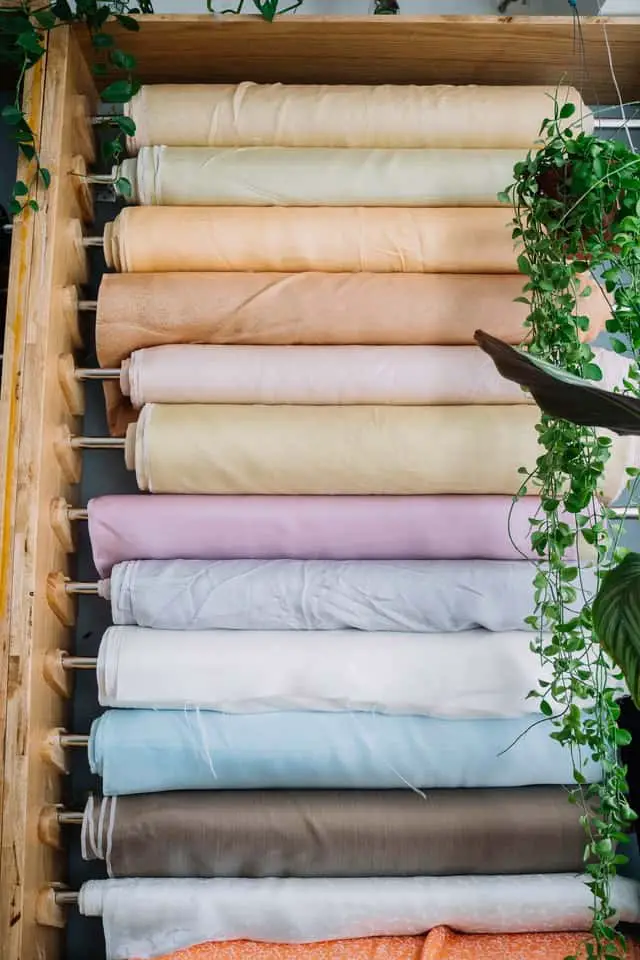Fabric selection can be overwhelming. Between different weights, makeups, qualities, and purposes, it can be difficult selecting the best type of fabric for your project. In this article, I will be sharing various types of fabrics and their properties, as well as sharing the best tips on how to choose more sustainable fabric for your project.
Natural Vs. Synthetic Fibres
Let me begin by explaining the difference between natural and synthetic fibers. Natural fibers are derived from organic sources. These fibers are produced from either animals or plants. Synthetic fibers are man made fibers produced by extruding fiber forming dope solution through spinnerets. After being exposed to air and/or water, this solution is formed into a thread. This thread is then woven or knitted into fabric. These dynamic fibers also come with multiple variations of properties. Below is a list of the five most commonly used natural and synthetic fibers. I will share with you their properties, and the best garment to construct the material out of.
Natural Fibers
Cotton (Organic and Conventional)
Organic and conventional cotton both have similar properties, however it is how they are grown that set the two apart. Conventional cotton is grown using pesticides to kill insects. These chemicals contaminate the earth. Organic cotton is grown with not genetically modified seeds and is typically a fair trade product. Organic cotton has longer and stronger fibers than conventional cotton.
Cotton is the most widely used fiber in the world. Almost 50% of the world’s demand for fiber is for cotton. Some benefits of cotton is that it has excellent strength ( its strength increases by up to 20% when wet). Cotton also has a strong abrasion resistance, is hydrophilic, biodegradable, easily dyeable, does not pill,and is easily dyeable. The negative properties of cotton cotton is its low luster, and poor resiliency. It shrinks, mildews, produces lint, is easily damaged by acid, bleach, sunlight, and high temperatures. Cotton is used in mens and womens wear. Garments such as dresses, undershirts, underwear, etc… are typically produced with 100% cotton. It is also optional to blend cotton with other fibers such as polyester or linen to give fabric different properties.
Wool
Wool fibers come from the outer fleece of sheep. It has an excellent hand, good resiliency, it’s fiber fluctuates with body temperatures, and is odor resistant. Despite all of wool’s great characteristics, there are many negative characteristics of wool as well. Wool loses strength when wet, and has poor luster. It’s end uses are for overcoats, suits, sweaters, carpets, upholstery, and felt fabric.
Silk
75% of all of the world’s silk is grown in Thailand and China. India is the largest consumer of silk in the world. All silk is grown from the insect bombyx mori ( more commonly known as the silk moth) who lays up to 600 eggs per day. After the eggs have hatched, they grow into caterpillars. These caterpillars are placed under a layer of gauze and mulberry leaves. Mulberry leaves are placed as food for the caterpillars. Once full, the caterpillars will begin to spin cocoons. While in their cocoons, caterpillars become pupas. The pupa will extrude silk from their mouths. Pupas will then leave their cocoons to lay eggs. Cocoons are softened in hot water to release the silk. The process of unwinding the silk fibers is called reeling. The fibers from each cocoon are combined with eight other fibers in a process called throwing
.
Silk is hydrophilic and hygroscopic. It is very lustrous, and has great absorbency and hand. Despite these great qualities, Silk is easily damaged by chlorine, sweat, and alkaline-based detergents. Though resistant to mold and mildew, silk is often attacked by carpet beetles and moths if precautions are not taken into account.
Silk can be used to make a wide variety of garments and accessories. Silk blouses, neckties, eveningwear, lingerie, and mens and womens undergarments are the most common uses for this textile because of its weight and hand. To maintain silk’s fibers to prevent stains and damages, soak silk in cold water with silk-friendly detergent. After five minutes, rinse with fresh water and hang dry.
Flax
Flax fibers are derived from the Linum usitatissimum plant. It’’s fibers are used to create linen textiles. Linen has great absorbency. It can absorb up to 20% of its weight in moisture. Linen has great strength, thermoregulation, abrasion resistance, and comfort. Linen is anti-allergic and non electrifying. Because of its thermoregulation properties, its fast wicking, and light weight, linen is perfect to construct undergarments or summer garments with. Linen does easily crease and wrinkle, so be sure to press it before and after wear.
Cashmere
Cashmere is made from the undercoat of Chinese and Mongolian Goats. Their fibers are soft, smooth, resilient, warming, and moisture absorbing. Because of these traits, cashmere is good for winter wear garments, such as scarves, gloves, and sweaters. Cashmere’s disadvantages are its short fibers which causes weakened strength.
Synthetic Fibers
Acrylic
Acrylic is a synthetic textile normally used to replace wool and fur textiles. It has a thick cover and a soft hand. It has low pilling properties, good resiliency and elasticity, is hydrophobic, and resistant to mildew and insects. However, it has low tendency, poor abrasion resistance, absorbency, and is heat sensitive. Because of its strength and hand, acrylic is great for sweaters, socks, and household items such as blankets and pillow covers.
Nylon
Nylon is the second most manufactured synthetic fiber in the United States. It was first commercially produced in 1939. Nylon has outstanding abrasion resistance. It is strong and lightweight, has excellent resiliency and elasticity. Out of all man-made synthetic textiles, nylon has the best absorbency, yet is hydrophobic. It is chemically stable which enables it to be washed and/or dry cleaned with other textiles. Nylon unfortunately does shrink under high temperatures. It experiences piling. Nylon is resistant to mildew and insects, but degrades in sunlight. This fiber is best known for making women’s tights. However, it can be used for carpeting, tire cord, parachutes, and ropes.
Polyester
Polyester is the #1 most worn manufactured textile in the United States. It can be products in various amounts of crimp, luster, and fiber length. What is so unique about this textile is its ability to manipulate it’s solution to create different properties. For example, a polyester’s hand can be modified to meet a specific company’s request. Pilling properties can also be manipulated by the manufacturer.
Typically, polyester has excellent abrasion resistance and strength. It is a medium weight fiber that has good elasticity. It possesses low absorbency qualities, but average wicking properties. Though hydrophobic, it is able to create lots of static. It is chemically resistant, and resistant to mildew and insects. Age has no effect on polyester, yet long exposure to sunlight will degrade this textile. Polyester can be used by itself, or blended with other fibers to create apparel and interior furnishings.
Rayon
Rayon was the first man-made fiber to be manufactured. It is a medium weight textile with great strength and abrasion resistance. However, it has poor elasticity and resisiancy. It is commonly used for mens and womens dresses, shirts, undergarments, and jackets. In industrial settings, it is used in hygiene products, medical products, and draperies.
Spandex
Spandex is manufactured elastic rubber. It is able to stretch and shrink back into its original shape (spandex can be stretched up to 700% of its original length before breaking. Its elastic recovery is 99%). It possesses great resiliency and dimensional stability, yet poor abrasion resistance and tenacity. Poor absorbency qualities, yet dyeable and chemically resistant. It is also resistant to mildew and insects. Spandex can be found in most garments such as denim, undergarments, pants, swimwear, and athleticwear.
What are my sustainable fabric options?
The fashion industry is the second largest contributor to pollution in the world. From toxic chemicals from dye baths entering our water sources, to hazardous greenhouse gas being emitted at the cost of textile production, the environment is poisoned at the hands of this industry. There are ways you can help reduce the amount of pollution created.
Recycle Fabric
Using scraps from previous projects, or fabric from garments that are no longer worn is a great way to cut down on waste created by disposable and old clothing. It is a great alternative than having old clothing take up space, or thrown into the landfill.
For bulk orders, one wise way to save on fabric is to order an exact amount of what is needed for the project. If a company is able to calculate the exact yardage of material needed for that specific garment, less fabric will be wasted. If by accident you ordered too much fabric, consider starting a smaller project with leftover material. For example, if you ordered too much acrylic fabric for a sweater, consider making a matching scarf or socks to pair with your garment.
Using Sustainable Fabric
Textiles deriving from natural fibers are more sustainable than synthetic fibers because they are able to degrade easier.
One example of a sustainable textile is cotton. Cotton is a commonly used fabric in the textile industry. Conventional cotton pollutes the Earth due to its extreme watering demands and pesticides. Organic cotton however is a more sustainable alternative because it is grown without poisonous pesticides. Upcycled cotton from post-consumer or post- industrial complexes is another environmentally conscious decision that cuts down on energy and waste.
Hemp is another sustainable textile option. Grown with very little water, no harmful pesticides, and produces its fertilizers naturally, it is a very ethical option.
Hemp can be used in many apparel garments such as jeans, shirrs, dresses, and accessories like hats and purses. It can also be used for ropes, building materials, paper, and canvas.
Finally, organic linen is another sustainable option for a textile project. As stated before, linen derives from the flax plant. Though grown with mineral water and pesticides, the entire flax plant is harvested and used in the creation of linen so nothing is wasted. If left untreated with dyes or finishes, linen is biodegradable. .
There is a plethora of fabric options available in the textile industry. Natural fibers offer great lightweight and warming options that are great options for making anything from a t-shirt to a suit. Synthetic fibers derive from a man made solution, with the option to manipulate its properties to create the textile perfect for your project. In terms of sustainability, there are lots of factors to consider when choosing an ethical textile such as biodegradability and growing options. There is also the opportunity to recycle and reuse textiles for future projects. Fabric selection is the one of the first and most important parts of the construction process. The outcome of your garment or product is founded on what materials it is made out of. I hope that you have learned about the many options you can choose from to help make a product you are impressed to call your own.








